Gregor Jahner
Gregor, please introduce yourself:
Heeeey, I’m Gregor, Designer and maybe artist? (depending on the definition) from Berlin. I graduated my masters last year at the University of Arts Berlin, since now I am doing my design stuff in a collaborative design studio in Schöneberg.
© Ulrich Zinell
#1 You define yourself as a queer designer and artist. What is your understanding of queer design and how did you find your way to the work you are doing right now?
During the last couple of years of studying design, I gradually came to understand that design is not merely a functional tool or a beauty makeover. Design defines how we live and interact. Everything around us is human-made. And by this I mean not only objects and materialities, but also systems, culture, politics, ideology, and morality, all of which are shaped by a designed world.
Design never was and never is “neutral.” Although—when we look at the commonly accepted definition of good design—we’re kinda expecting neutrality from it (bless you, Dieter Rams <3). But in fact, if we follow this logic further, we can observe how design carries histories, norms, and, most of all, power structures. It becomes a kind of scaffolding that reinforces norms and standards which, in turn, have a political impact on us and shape social hierarchies. Based on this conviction, I build my praxis around “queering design” as an antithesis to the norm and to neutrality. By queering something, I start to reimagine history and begin to unlearn the things we take for granted. It opens up perspectives that challenges and disrupts the dominant narratives shaping our world.
#2 Your work also explores the topics of sexuality and sexual orientation, as well as BDSM as a sexual practice. What led you to focus on these topics within the field of product design? How can design and architecture, in your opinion, break down social norms and raise awareness in the context of sexuality?
Sexuality has existed since the very beginning of human being (obviously, otherwise none of us would be here), and yet it is a constantly changing and adapting phenomenon throughout history that submits to the rules of institutions and social discourses. BDSM, in this sense, is an excellent metaphor for illuminating these power structures through the role-play of Doms and Subs. I think this was my motivation to design the Gag Light, but also a bit of curiosity: What happens if the wearer themselves becomes a furniture piece, when the subject becomes the object?
But to follow up on your second question: Sexual awareness emerges through open and meaningful exchange with one another. The sex-positivity movement, for example, defines its code of conduct only under the condition of mutual and consensual agreement among all participants. That requires a minimum level of sex education, respect for each other and a sense of empathy. This, in turn, requires the opportunity to exchange and learning from each other. Design and architecture can offer these opportunities in form of spaces and guidelines for this mutual get-together. And by that I don’t (necessarily) mean swinger clubs or darkrooms, but rather things like e.g. community guidelines in social media comment sections, anti-sexism training in schools or workplaces, awareness teams at big events, or even gender-neutral restrooms. All these physical and non-physical spaces can be planned and designed to enable safer spaces for everyone.
© Gregor Jahner
#3 In your Master's thesis, you examined the concept of 'queering' something, with a particular focus on communal bathrooms as fluid and contested spaces that reinforce outdated gender concepts. Could you tell us more about your research and your design of 'queering bathrooms’?
The Queering Bathrooms project is about the affect-driven and politically instrumentalized debates on gender-neutral restrooms. To counter the arguments of TERFs and right-wing parties that deny or delegitimize trans* and non-binary identities, I designed a toilet that sticks out its tongue at the viewer, confronting us with a reminder of how natural and unquestioned the most everyday things are for many of us, like going to the toilet, while for others this is often tied to experiences of exclusion, structural marginalization, or even violence.
In this debate, both opponents and proponents of gender-neutral toilets argue for greater safety within these architectures. I say there are possibilities to make safe spaces for everyone. But this won’t happen as long as a majority of people question the legitimacy of trans* and non-binary identities. My goal in this project was to inform and to gain an overview of this emotionally charged topic. I made a film, Toilet Stories, where different people were interviewed about their different experiences and opinions on public toilets in general and gender-neutral restrooms, discussing architectural solutions and opening up utopias where safe spaces for everyone can actually exist. Reality, however, shows that society still has a long way to go in accepting and thinking beyond. But this is a fight I’m absolutely committed to.
#4 Your Pierced Stool and Peach Lamp designs take a playful approach to drawing attention to themes of sexuality and queerness, combining them with craftsmanship. What is particularly important to you when combining socially relevant themes with aesthetics and craftsmanship?
I’d say that craftsmanship here is just the tool to transport a story, like a lot of other contemporary designers are doing right now. Of course, I do love to experiment a lot with materials like glass, porcelain, metal, and leather. But what really empowers me is the emotional impact the objects have on us. I love having the possibility of subverting everyday objects, twisting their meaning, and observing the reactions of different people who see my work. Most of the time, people agree with it. I don’t know if it’s just the echo chamber of the left woke bubble I am part of, or maybe particularly the materials and their craftsmanship that actually resonate. Of course, I have also had experiences where my work faced disagreement. And this is what I am here for.
© Gregor Jahner
#5 What is your wish for the current generation of designers and architects in terms of challenging preconceptions and encouraging a shift in thinking regarding social norms?
„Was du nicht willst das man dir tut, das das füg’ auch keiner*keinem Anderen zu.“ We learned this in Kindergarten. We should not forget.
#6 Are there any topics that interest or concern you that you would like to explore in the context of queer design in the future?
Currently, I am spending a lot of time reflecting on my own heritage. My parents come from Russia and came to Germany years before the Perestroika. My mother always told me: “You can be glad you didn’t grow up in Russia.” This sentence sticks in my mind like a big Post-it note, and I know I need to do something with it. Therefore, in the coming months, I feel the urge to certainly focus on my German-Russian culture and on the homophobic Russian regime.


© Gregor Jahner
#7 How do you see the role of an architect in today's society?
The role of a designer and architect in this century is more important than ever. The designer and architect as a transdisciplinary multi-talent, which everyone seems to expect nowadays, has to deal with so many layers. We have the toolkit to juxtapose these layers. At this point, I’d like to encourage everyone in this sinking ship of post-capitalism to stop believing that design is, and will forever be, the product of blind faith in progress and productivity. The practice of designing things can open up so many new perspectives when we sometimes get rid of the expectations of capitalism. So be brave with your ideas. We urgently need them. We are already sitting in the burning house of global ecological and social catastrophes.
#8 How does your environment influence your work?
Well, a big influence is, of course, queer culture, how it is constantly emerging but still fighting for its rights. I find it fascinating how, even just a few years ago, it mostly manifested itself within subcultures before finding its way to the surface through pop culture. Nowadays, these borders are blurring more and more, especially through social media. This is a very important development which affects all of us. As we can see from current developments by opponents weaponizing against the LGBTQ+ community, it is still in a very fragile state that needs to be protected.



Photo 01: © Gregor Jahner, Photo 02 + 03: © Leander von Thien
#9 Three things that inspire you at the moment?
The exhibition Global Fascisms at the HKW Berlin, and, to be honest, having quality time with my friends.
#10 What do you currently read, watch, listen to?
Honestly, currently I am watching a lot of trash tv and started rewatching The Crown on Netflix. I do hear a lot of music. Currently, I’m stuck with indie sleaze classics from the 2010’s. This month I said adieu to Spotify (X). I share a Tidal Family account with friends. Way cheaper and the artists get what they deserve.
Links
Instagram: @gregorjahner
Website: gregorjahner.de
Photos: Ulrich Zinell, © Leander von Thien, © Gregor Jahner
Interview by Loretta Pittino







